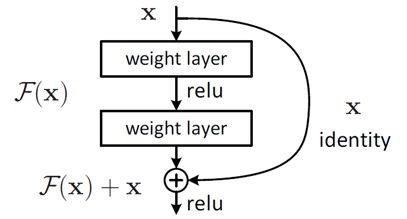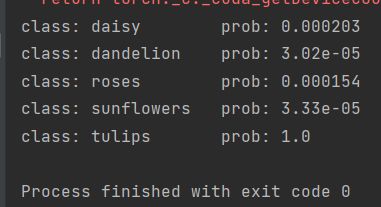Pytorch搭建ResNet
Pytorch搭建ResNet
1、网络架构
ResNet的网络架构这里就不做过多解释,论文原文网络结构如下图,详细可以参照你必须要知道CNN模型:ResNet
2、环境搭建
pytorch版本:1.10.2
python版本:3.6.15
pytorch的安装教程可以参照pytorch的安装和入门使用
3、模型搭建
3.1 定义ResNet[18,34]基础残差块BasicBlock
-
expansion用来区分残差结构中不同层卷积核的个数,(50,101,152)的残差块中的第三层卷积和个数时是第一层和第二层的4倍。
class BasicBlock(nn.Module): expansion = 1 # 用来区分残差结构中不同层卷积核的个数 # (50,101,152的残差块中的第三层卷积和个数时是第一层和第二层的4倍,这里就应该写4) -
在init函数中初始化残差块需要用到的结构
-
in_channel:残差块输入的通道数
-
out_channel:残差块输出的通道数
-
stride:卷积核移动的步长
-
downsample:下采样方法,默认为空(例如:网络架构中conv2.x的输出为[56,56,64],但是conv3.x中需要的输入为[28,28,128],所以需要下采样,对应下图虚线处的残差结构)
def __init__(self, in_channel, out_channel, stride=1, downsample=None): super(BasicBlock, self).__init__() self.conv1 = nn.Conv2d(in_channels=in_channel, out_channels=out_channel, kernel_size=3, stride=stride, padding=1, bias=False) self.bn1 = nn.BatchNorm2d(out_channel) self.relu = nn.ReLU() self.conv2 = nn.Conv2d(in_channels=out_channel, out_channels=out_channel, kernel_size=3, stride=1, padding=1, bias=False) self.bn2 = nn.BatchNorm2d(out_channel) self.downsample = downsample -
-
编写forward函数,定义模型的前向传输过程
- identity用来表示残差结构的支线
- out表示残差结构的主线
def forward(self, x): identity = x if self.downsample is not None: identity = self.downsample(x) out = self.conv1(x) out = self.bn1(out) out = self.relu(out) out = self.conv2(out) out = self.bn2(out) out += identity out = self.relu(out) return out
3.2 定义ResNet[50,101,152]的基础残差块Bottleneck
-
50,101,152的残差块中的第三层卷积和个数时是第一层和第二层的4倍,因此定义expansion为4
class Bottleneck(nn.Module): expansion = 4 -
在init函数中初始化残差块需要用到的结构
def __init__(self, in_channel, out_channel, stride=1, downsample=None): super(Bottleneck, self).__init__() self.conv1 = nn.Conv2d(in_channels=in_channel, out_channels=out_channel, kernel_size=1, stride=stride, bias=False) self.bn1 = nn.BatchNorm2d(out_channel) self.conv2 = nn.Conv2d(in_channels=out_channel, out_channels=out_channel, kernel_size=3, stride=1, padding=1, bias=False) self.bn2 = nn.BatchNorm2d(out_channel) self.conv3 = nn.Conv2d(in_channels=out_channel, out_channels=out_channel * self.expansion, kernel_size=1, stride=1, bias=False) self.bn3 = nn.BatchNorm2d(out_channel * self.expansion) self.relu = nn.ReLU(inplace=True) self.downsample = downsample -
编写forward函数,定义模型的前向传输过程
def forward(self, x): identity = x if self.downsample is not None: identity = self.downsample(x) out = self.conv1(x) out = self.bn1(out) out = self.relu(out) out = self.conv2(out) out = self.bn2(out) out = self.relu(out) out = self.conv3(out) out = self.bn3(out) out += identity out = self.relu(out) return out
3.3 定义ResNet整体网络结构
-
定义_make_layer函数:用来构建网络架构中的(conv2.x,conv3.x,conv4.x,conv5.x)
- block:基础残差结构(根据定义的网络层数不同,传入不同的残差结构,[18,34]传BasicBlock,[50,101,152]传Bottleneck)
- channel:残差结构中第一个卷积层使用的卷积核的个数
- block_num:该层包含多少个残差结构
- stride:卷积和移动的步距
- 什么时候分支需要进行下采样:
- 对于所有的resnet结构,在conv2.x—>conv3.x—>conv4.x—>conv5.x的途中分支都需要进行下采样(stride=2)
- 对于resnet[50,101,152]网络结构来说,从maxpool层进入conv2.x时分支也需要进行一次“下采样”,这次“下采样”只改变深度,不改变高度和宽度(stride=1)。
def __make_layer(self, block, channel, block_num, stride=1): downsample = None if stride != 1 or self.in_channel != channel * block.expansion: # 判断是否进行下采样 downsample = nn.Sequential( nn.Conv2d(self.in_channel, channel * block.expansion, kernel_size=1, stride=stride, bias=False), nn.BatchNorm2d(channel * block.expansion) ) layers = [] layers.append(block(self.in_channel, channel, downsample=downsample, stride=stride)) # 添加第一个残差基础块 self.in_channel = channel * block.expansion # 对于18,34层的网络,经过第一个残差块后,输出的特征矩阵通道数与第一层的卷积层个数一样 # 对于50,101,152层的网络,经过第一个残差块后,输出的特征矩阵通道数时第一个卷积层的4倍,因此要将后续残差块的输入特征矩阵通道数调整过来 for _ in range(1, block_num): # 添加后续的基础残差模块,后续的基础模块都不需要进行下采样操作 layers.append(block(self.in_channel, channel)) return nn.Sequential(*layers) -
在init函数中初始化网络需要用到的结构
- block:基础残差结构
- block_num:列表参数,标注所使用残差结构的数目,对应网络架构图中的数目
- num_classes:训练集分类个数
- include_top:resnet网络上接其他网络,构成更复杂的网络
def __init__(self, block, block_num, num_classes=1000, include_top=True): super(ResNet, self).__init__() self.include_top = include_top self.in_channel = 64 # maxpooling之后得到的特征矩阵的深度 self.conv1 = nn.Conv2d(in_channels=3, out_channels=self.in_channel, kernel_size=7, stride=2, padding=3, bias=False) self.bn1 = nn.BatchNorm2d(self.in_channel) self.relu = nn.ReLU(inplace=True) self.maxpool = nn.MaxPool2d(kernel_size=3, stride=2, padding=1) self.layer1 = self.__make_layer(block, 64, block_num[0]) self.layer2 = self.__make_layer(block, 128, block_num[1], stride=2) self.layer3 = self.__make_layer(block, 256, block_num[2], stride=2) self.layer4 = self.__make_layer(block, 512, block_num[3], stride=2) if self.include_top: self.avgpool = nn.AdaptiveAvgPool2d(1, 1) self.fc = nn.Linear(512 * block.expansion, num_classes) for m in self.modules(): # 初始化模型参数 if isinstance(m, nn.Conv2d): nn.init.kaiming_normal_(m.weight, mode='fan_out', nonlinearity='relu') -
编写forward函数,定义模型的前向传输过程
def forward(self, x): x = self.conv1(x) x = self.bn1(x) x = self.relu(x) x = self.maxpool(x) x = self.layer1(x) x = self.layer2(x) x = self.layer3(x) x = self.layer4(x) if self.include_top: x = self.avgpool(x) x = torch.flatten(x, 1) x = self.fc(x) return x -
定义resnet不同层数的网络
def resnet18(num_classes=1000, include_top=True): return ResNet(BasicBlock, [2, 2, 2, 2], num_classes=num_classes, include_top=include_top) def resnet34(num_classes=1000, include_top=True): return ResNet(BasicBlock, [3, 4, 6, 3], num_classes=num_classes, include_top=include_top) def resnet50(num_classes=1000, include_top=True): return ResNet(Bottleneck, [3, 4, 6, 3], num_classes=num_classes, include_top=include_top) def resnet101(num_classes=1000, include_top=True): return ResNet(Bottleneck, [3, 4, 23, 3], num_classes=num_classes, include_top=include_top) def resnet34(num_classes=1000, include_top=True): return ResNet(Bottleneck, [3, 8, 26, 3], num_classes=num_classes, include_top=include_top)
4、训练
4.1 下载官方提供的ResNet网络的与训练模型参数
model_urls = {
'resnet18': 'https://download.pytorch.org/models/resnet18-f37072fd.pth',
'resnet34': 'https://download.pytorch.org/models/resnet34-b627a593.pth',
'resnet50': 'https://download.pytorch.org/models/resnet50-0676ba61.pth',
'resnet101': 'https://download.pytorch.org/models/resnet101-63fe2227.pth',
'resnet152': 'https://download.pytorch.org/models/resnet152-394f9c45.pth',
'resnext50_32x4d': 'https://download.pytorch.org/models/resnext50_32x4d-7cdf4587.pth',
'resnext101_32x8d': 'https://download.pytorch.org/models/resnext101_32x8d-8ba56ff5.pth',
'wide_resnet50_2': 'https://download.pytorch.org/models/wide_resnet50_2-95faca4d.pth',
'wide_resnet101_2': 'https://download.pytorch.org/models/wide_resnet101_2-32ee1156.pth',
}
4.2 数据集准备
-
获取花分类数据集,放在data_set/flower_data文件夹下
-
使用split.py划分训练集和测试集
import os from shutil import copy, rmtree import random def mk_file(file_path: str): if os.path.exists(file_path): # 如果文件夹存在,则先删除原文件夹在重新创建 rmtree(file_path) os.makedirs(file_path) def main(): # 保证随机可复现 random.seed(0) # 将数据集中10%的数据划分到验证集中 split_rate = 0.1 # 指向你解压后的flower_photos文件夹 cwd = os.getcwd() data_root = os.path.join(cwd, "flower_data") origin_flower_path = os.path.join(data_root, "flower_photos") assert os.path.exists(origin_flower_path), "path '{}' does not exist.".format(origin_flower_path) flower_class = [cla for cla in os.listdir(origin_flower_path) if os.path.isdir(os.path.join(origin_flower_path, cla))] # 建立保存训练集的文件夹 train_root = os.path.join(data_root, "train") mk_file(train_root) for cla in flower_class: # 建立每个类别对应的文件夹 mk_file(os.path.join(train_root, cla)) # 建立保存验证集的文件夹 val_root = os.path.join(data_root, "val") mk_file(val_root) for cla in flower_class: # 建立每个类别对应的文件夹 mk_file(os.path.join(val_root, cla)) for cla in flower_class: cla_path = os.path.join(origin_flower_path, cla) images = os.listdir(cla_path) num = len(images) # 随机采样验证集的索引 eval_index = random.sample(images, k=int(num*split_rate)) for index, image in enumerate(images): if image in eval_index: # 将分配至验证集中的文件复制到相应目录 image_path = os.path.join(cla_path, image) new_path = os.path.join(val_root, cla) copy(image_path, new_path) else: # 将分配至训练集中的文件复制到相应目录 image_path = os.path.join(cla_path, image) new_path = os.path.join(train_root, cla) copy(image_path, new_path) print("\r[{}] processing [{}/{}]".format(cla, index+1, num), end="") # processing bar print() print("processing done!") if __name__ == '__main__': main()
4.3 构建train.py文件
-
定义数据标准化处理方式(这里的normalize的参数为官方提供的参数)
data_transform = { "train": transforms.Compose([transforms.RandomResizedCrop(224), transforms.RandomHorizontalFlip(), transforms.ToTensor(), transforms.Normalize([0.485, 0.456, 0.406], [0.229, 0.224, 0.225])]), "val": transforms.Compose([transforms.Resize(256),# 最小边缩放 transforms.CenterCrop(224),# 中心裁剪 transforms.ToTensor(), transforms.Normalize([0.485, 0.456, 0.406], [0.229, 0.224, 0.225])])} -
载入数据集
data_root = os.path.abspath(os.path.join(os.getcwd(), "../..")) # get data root path image_path = os.path.join(data_root, "data_set", "flower_data") # flower data set path assert os.path.exists(image_path), "{} path does not exist.".format(image_path) train_dataset = datasets.ImageFolder(root=os.path.join(image_path, "train"), transform=data_transform["train"]) train_num = len(train_dataset) # {'daisy':0, 'dandelion':1, 'roses':2, 'sunflower':3, 'tulips':4} flower_list = train_dataset.class_to_idx cla_dict = dict((val, key) for key, val in flower_list.items()) # write dict into json file json_str = json.dumps(cla_dict, indent=4) with open('class_indices.json', 'w') as json_file: json_file.write(json_str) batch_size = 16 train_loader = torch.utils.data.DataLoader(train_dataset, batch_size=batch_size, shuffle=True, num_workers=0) validate_dataset = datasets.ImageFolder(root=os.path.join(image_path, "val"), transform=data_transform["val"]) val_num = len(validate_dataset) validate_loader = torch.utils.data.DataLoader(validate_dataset, batch_size=batch_size, shuffle=False, num_workers=0) print("using {} images for training, {} images for validation.".format(train_num, val_num)) -
初始化网络模型并载入预训练参数(由于使用cpu进行训练,为了节省时间使用了迁移学习的方法)
net = resnet34() model_weight_path = "./pth/resnet34-pre.pth" assert os.path.exists(model_weight_path), "file {} does not exist.".format(model_weight_path) net.load_state_dict(torch.load(model_weight_path, map_location='cpu')) # for param in net.parameters(): # param.requires_grad = False -
修改最后全连接层的输出类别数量(这里只预测5类)
# change fc layer structure in_channel = net.fc.in_features net.fc = nn.Linear(in_channel, 5) net.to(device) -
定义损失函数和优化器
# define loss function loss_function = nn.CrossEntropyLoss() # construct an optimizer params = [p for p in net.parameters() if p.requires_grad] optimizer = optim.Adam(params, lr=0.0001) -
定义一些初始化参数(epoch,模型参数保存路径等)
epochs = 3 best_acc = 0.0 save_path = './resNet34.pth' train_steps = len(train_loader) -
开始训练,打印训练结果
for epoch in range(epochs): # train net.train() running_loss = 0.0 train_bar = tqdm(train_loader, file=sys.stdout) for step, data in enumerate(train_bar): images, labels = data optimizer.zero_grad() logits = net(images.to(device)) loss = loss_function(logits, labels.to(device)) loss.backward() optimizer.step() # print statistics running_loss += loss.item() train_bar.desc = "train epoch[{}/{}] loss:{:.3f}".format(epoch + 1, epochs, loss) # validate net.eval() acc = 0.0 # accumulate accurate number / epoch with torch.no_grad(): val_bar = tqdm(validate_loader, file=sys.stdout) for val_data in val_bar: val_images, val_labels = val_data outputs = net(val_images.to(device)) # loss = loss_function(outputs, test_labels) predict_y = torch.max(outputs, dim=1)[1] acc += torch.eq(predict_y, val_labels.to(device)).sum().item() val_bar.desc = "valid epoch[{}/{}]".format(epoch + 1, epochs) val_accurate = acc / val_num print('[epoch %d] train_loss: %.3f val_accuracy: %.3f' % (epoch + 1, running_loss / train_steps, val_accurate)) if val_accurate > best_acc: best_acc = val_accurate torch.save(net.state_dict(), save_path) print('Finished Training')
5、预测
注意:预测时,对于数据的标准化处理方式要采用和训练时的一致的处理方式
python
import os
import json
import torch
from PIL import Image
from torchvision import transforms
import matplotlib.pyplot as plt
from model import resnet34
def main():
device = torch.device("cuda:0" if torch.cuda.is_available() else "cpu")
data_transform = transforms.Compose(
[transforms.Resize(256),
transforms.CenterCrop(224),
transforms.ToTensor(),
transforms.Normalize([0.485, 0.456, 0.406], [0.229, 0.224, 0.225])])
# load image
img_path = "./tulipa.jpg"
assert os.path.exists(img_path), "file: '{}' dose not exist.".format(img_path)
img = Image.open(img_path)
plt.imshow(img)
# [N, C, H, W]
img = data_transform(img)
# expand batch dimension
img = torch.unsqueeze(img, dim=0)
# read class_indict
json_path = './class_indices.json'
assert os.path.exists(json_path), "file: '{}' dose not exist.".format(json_path)
json_file = open(json_path, "r")
class_indict = json.load(json_file)
# create model
model = resnet34(num_classes=5).to(device)
# load model weights
weights_path = "./resNet34.pth"
assert os.path.exists(weights_path), "file: '{}' dose not exist.".format(weights_path)
model.load_state_dict(torch.load(weights_path, map_location=device))
# prediction
model.eval()
with torch.no_grad():
# predict class
output = torch.squeeze(model(img.to(device))).cpu()
predict = torch.softmax(output, dim=0)
predict_cla = torch.argmax(predict).numpy()
print_res = "class: {} prob: {:.3}".format(class_indict[str(predict_cla)],
predict[predict_cla].numpy())
plt.title(print_res)
for i in range(len(predict)):
print("class: {:10} prob: {:.3}".format(class_indict[str(i)],
predict[i].numpy()))
plt.show()
if __name__ == '__main__':
main()






